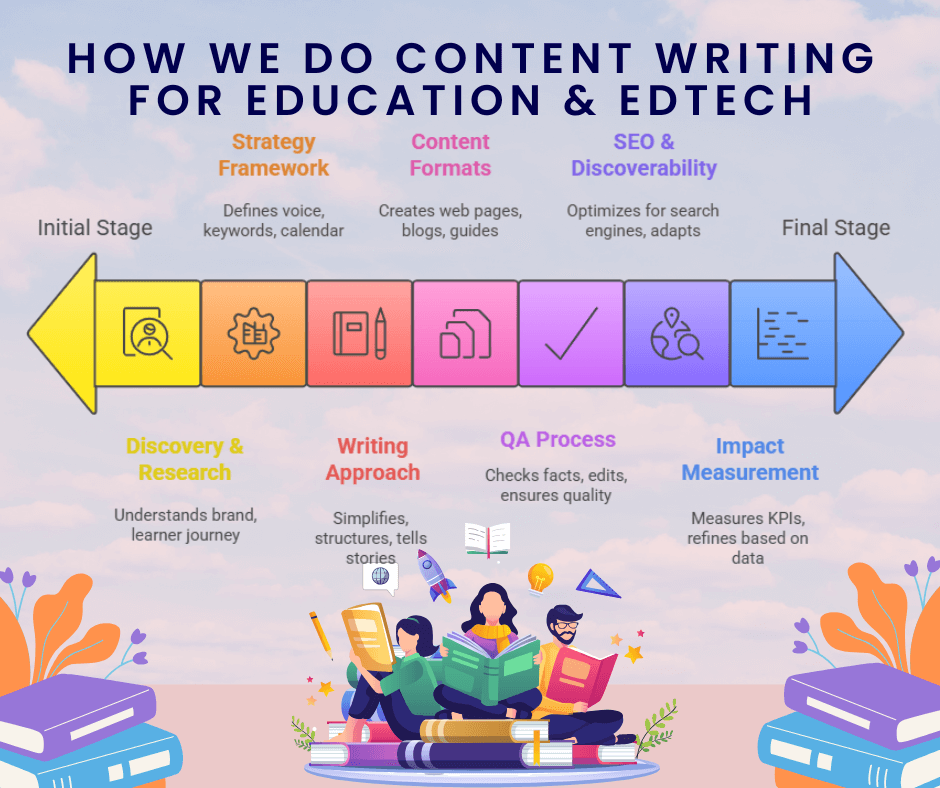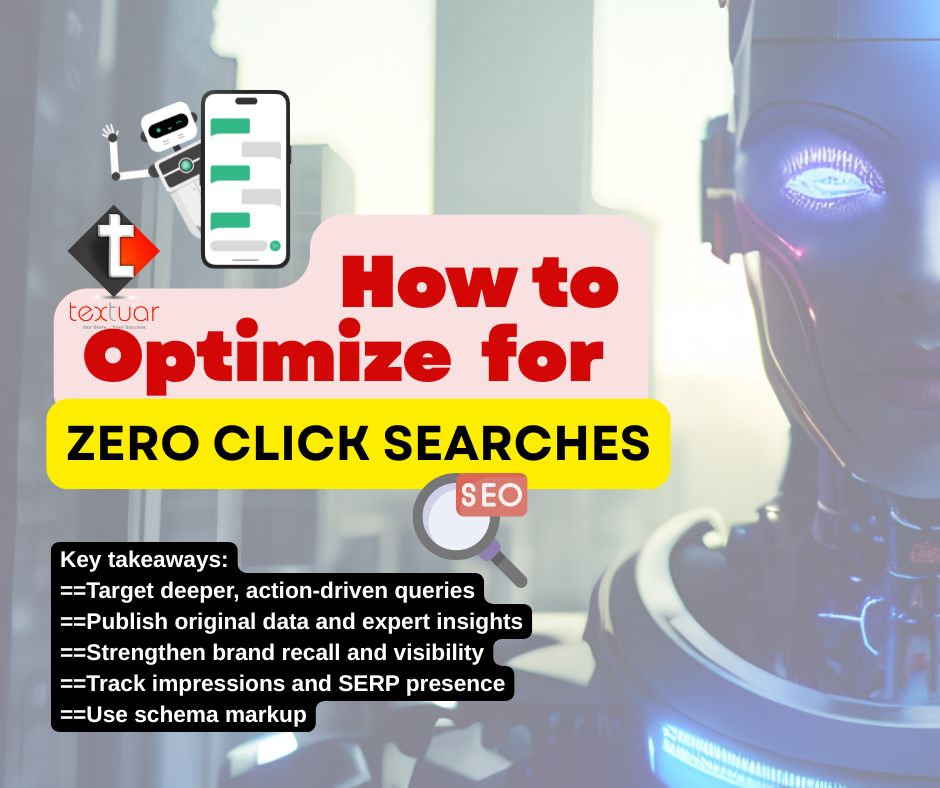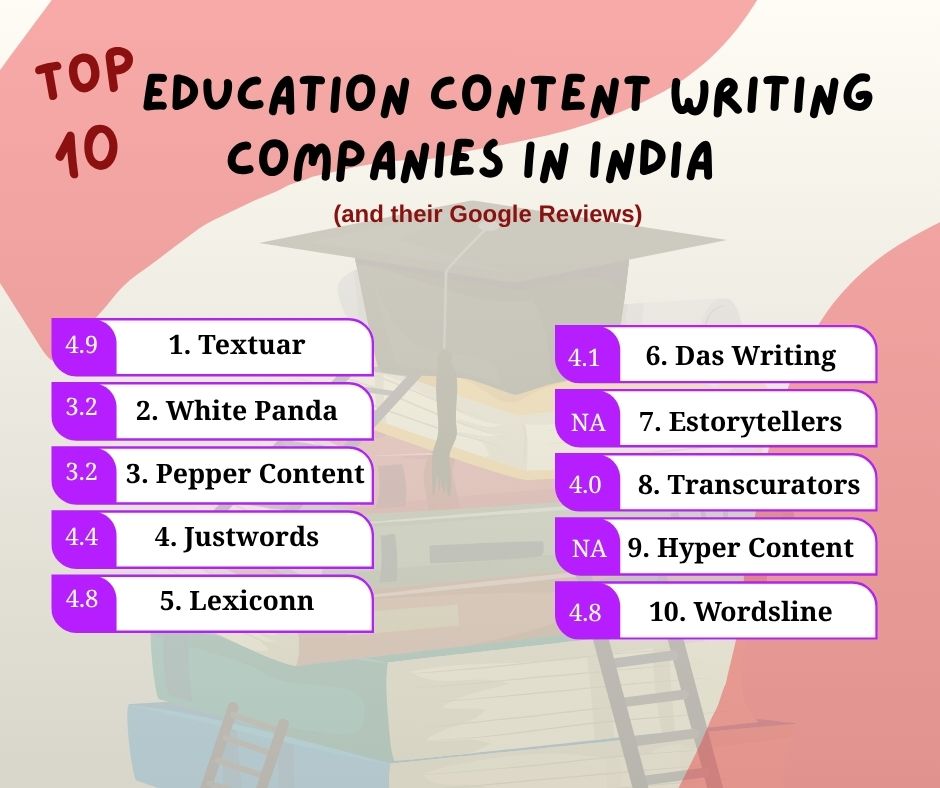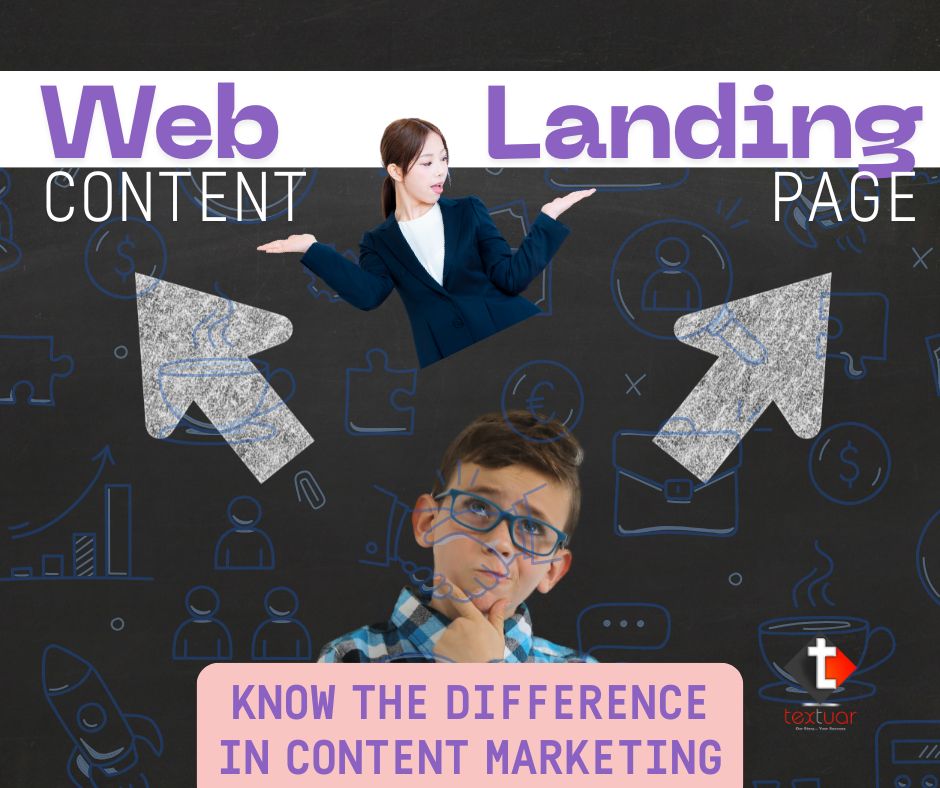📌 TL;DR – Quick Summary
Creating eLearning content that delivers real outcomes requires a proven process. This blog explores all the aspects to help you in eLearning content development:
-Who benefits from online training content?
-Expert tips on engaging eLearning content development.
-Different eLearning content formats and how they influence the learning experience.
-Tips on choosing the right agency like Textuar for eLearning content development needs.
Learning is no more confined to four walls of a classroom. Learners now expect content that is digital and interactive. They want their learning resources to be accessible anytime and anywhere. That is where eLearning content development comes in. This is the process of designing meaningful online experiences that inform and inspire. It blends creativity and technology to turn knowledge into action.
The global demand for education is on the rise. And high-quality content has become inevitable for the creation of successful learning programmes. Research shows that digital learning helps improve retention, assisting students in remembering 60% or more of information. The ability to revisit material as needed is the driving factor here. Also, modern eLearning caters to diverse audiences and learning styles, thanks to a variety of format types.
So, the question remains, “How do you develop eLearning content that matches the expectations and trends?” This blog is here to help. Let us explore the practical insights, pitfalls, and other aspects of developing online training content.
What is eLearning content development?
eLearning content development is a systematic way of creating educational materials for digital platforms. Expert writers turn knowledge or skills into formats learners can easily access online.
It is more than just uploading slides or documents. Effective eLearning blends instructional design and interactivity. It also features multimedia. The goal is to engage learners while meeting clear learning objectives. Also, the created content is often clear and easy to go through. This ensures learners can focus on comprehension instead of struggling with the platform.
Good online learning content adapts to different learning styles and paces. It makes available meaningful experiences, not just facts.
Who Needs eLearning Content?
eLearning content is not just for one type of organisation or learner. Many different entities obtain real advantages from investing in online learning content. Here are five of them.
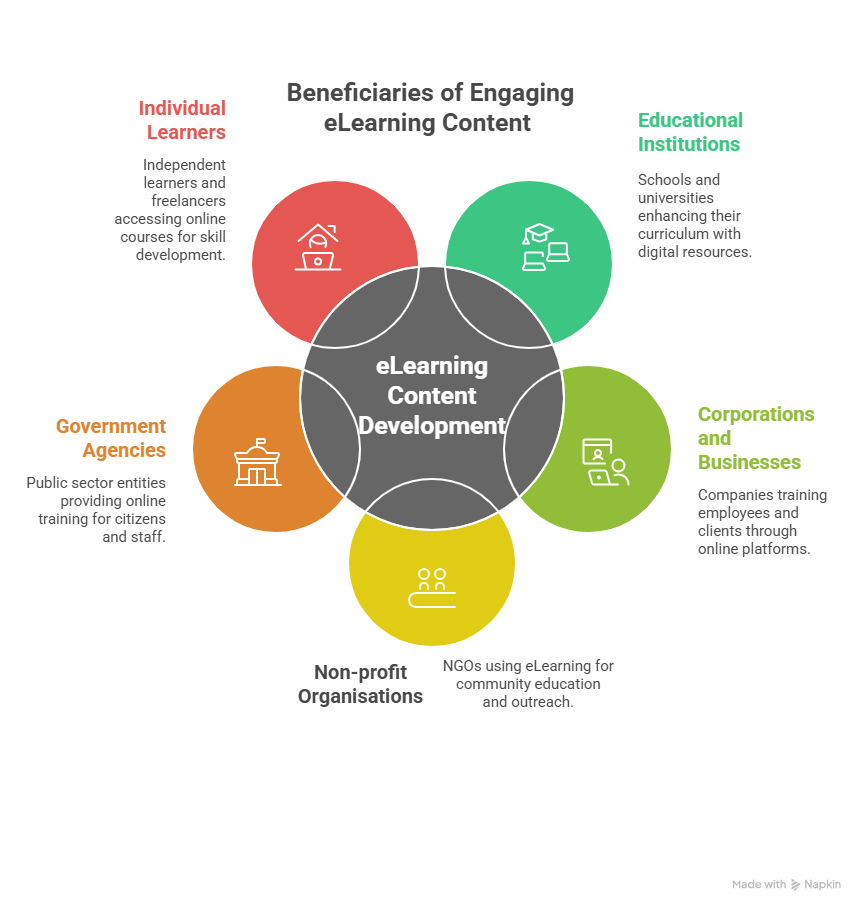
1- Educational institution
Major benefits are experienced by schools and colleges from eLearning content. How, you might ask? Well, eLearning content can make it possible for educational institutions to offer online or blended courses. This helps in reaching more students hassle-free.
Institutions could also use online content to supplement in-class learning. This way, accessibility to notes becomes streamlined. Learners are able to revise or study at their pace.
2- Corporations and businesses
Companies can use online learning content to train employees efficiently. This could streamline onboarding and compliance. In fact, upskilling or reskilling becomes easy when online content is already created and maintained.
Organisations also save on travel associated with training or booking a venue for the same. Lastly, eLearning helps maintain consistency. Every employee receives the same core training.
3- Non-profit organisations and NGOs
NPOs and NGOs often work in remote areas or underserved regions. Travelling with physical training copies at such locations is definitely a stressful job.
Thankfully, eLearning content puts an end to that. It allows us to deliver education and health training on the go. It becomes easy to conduct awareness campaigns for distant audiences. This offers flexibility. Also, the cost of delivering important messages is reduced.
4- Government agencies and the public sector
Government benefits immensely by investing in eLearning content development services. For instance, training large populations or civil service staffs becomes easy with online training materials.
eLearning content helps with policy training and public health programmes. It aids with vocational skills and regulatory compliance, too.
5- Individual learners and freelancers
Online learning content is heavily favoured by students and professionals. It allows them to upskill to change careers or learn for pleasure. They get a chance to learn at their pace and at their time.
Also, varied formats help with retention. The learning journey becomes even more engaging.
What are the 5 Main Types of eLearning Content?
eLearning content, today, can be made in different formats. Each of these forms meets different learning goals. Let’s learn about the most effective online training content types below –
1- Slide presentations
The most popular types of eLearning content are slide presentations. They provide well-organised information in a structured way.
You can use the tools Microsoft PowerPoint and Google Slides to create informative slides. These slides are often seen during webinars or lectures. They may consist of text and pictures. Some also feature videos for better understanding.
LinkedIn Learning, for instance, employs slide-based courses to help explain aspects of marketing to coding.
2- Quizzes
Quizzes make the learning interactive. They challenge the comprehension and strengthen the knowledge immediately after the concept is introduced.
A lot of eLearning websites use quizzes today. Their idea is to check the progress and to facilitate memorisation.
This type of online content works well to check or test knowledge. You can use it to take feedback from learners, too.
3- Podcast
Podcasts are an audio-based learning model for learning on the go. They work well for expert interviews. You can use them for discussions on a topic or storytelling.
Also, since there isn’t much visual interaction happening during podcasts, the writing needs to be unique. For instance, a conversational or narrative style of eLearning writing works best for this type of online content.
4- E-books
E-books offer richness and contentment to people who love reading. They are great supplements to online courses.
Platforms such as HubSpot combine e-books with courses. As a result, learners gain access to easy reference material on topics like SEO or customer service.
E-books make an excellent investment to aid people who prioritise research-based learning.
5- Infographics
Complicated information is not always easy to deliver in simple formats. Infographics make it easy to do so. It transforms intricate data into visual narratives. The use of charts and diagrams simplifies the ideas. They make memorising data easy, too.
Salesforce, as an example, relies on the use of infographics to detail complex procedures of products.
Infographics work best to summarise data. You can use them to explain steps. Or, present statistics in an appealing manner.
What are the Core Elements of Successful Online Training Content?
Creating a successful ecosystem of quality online content starts from a careful eLearning content development phase. The process demands careful planning and a learner-centred approach.
These six core elements ensure your programme informs and delivers measurable outcomes.
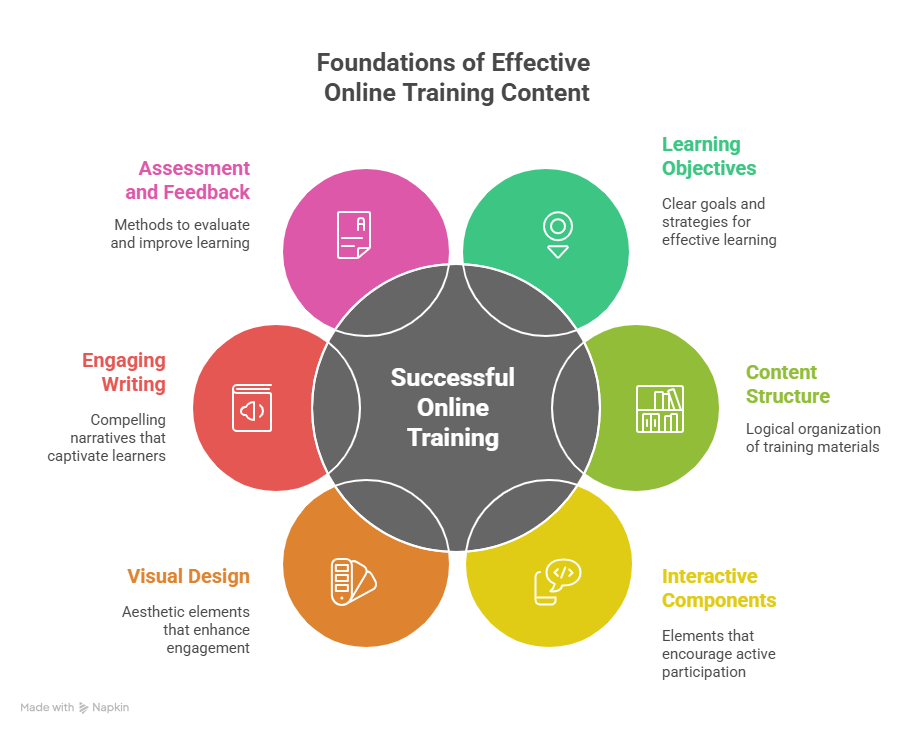
1- Clear learning objectives and strategy
Any successful eLearning programme is initiated with clear objectives. These define what learners must know or achieve by the end of training. An effective plan ensues, with a road map to achieving those objectives based on systematic content, practice and assessment.
For instance, a software-onboarding course might focus on step-by-step tutorials. Or, it may give guided practice to build confidence.
Staying aligned with the needs of the learners will make the content relevant. It will have a purpose at any given stage.
2- Logical content structure
A well-organised design assists learners to consume and retain knowledge. Courses that move logically from basic to advanced topics build confidence. They prevent information overload. Similarly, breaking lessons into short, focused modules enhances understanding. As a result, the learners remain engaged.
For instance, a compliance course can be divided into separate modules for each regulation. This will help employees grasp one concept before moving to the next. Ensure to maintain smooth transitions with visual cues or summaries. That will aid in a smooth learning process.
3- Interactive components for learning
Interactivity in eLearning content development changes learning into an active experience. Quizzes or branching scenarios, for instance, allow learners to apply their knowledge instantly. For the sales team, role-playing exercises could help practise objection handling in realistic settings. An element of gamification, such as challenges or badges, can provide motivation.
Also, these tools suit the various learning styles. They provide a hands-on interactive environment that enhances understanding.
4- Strong visual design
The visual design influences the perceptions and processing of information by learners. Clear layouts and regular typography contribute to clarity. Similarly, a consistent colour palette allows for consistency.
Complex concepts become easy to understand with visual aids. These include infographics, animations and even diagrams. For instance, detailed visuals in a medical training module can explain medical anatomy easily. They could simplify clinical procedures for novices.
The idea is to make intuitive and appealing content that supports easy learning.
5- Engaging writing and storytelling
Effective writing entices the learners to read more. That is why it is critical to avoid jargon in online training content. If used, it is imperative that you explain them in simple language. Similarly, the tone of the content should be professional yet conversational. The use of storytelling or analogies can help transform abstract ideas into relatable experiences.
If you are writing a leadership course, equip the eLearning content development with real-life stories from industry experts. This will inspire reflection.
Consistency in tone and vocabulary creates trust. It also makes the learners remain connected during the course.
6- Assessment and feedback
Assessment helps ensure the learning objectives are met. So, go beyond quizzes and add practical, scenario-based exercises. The goal is to offer deeper evaluation. For instance, ask your learners to design a simple campaign while they undergo a digital marketing course. Following such activities, you can provide them constructive feedback, which can help identify areas of strengths and weaknesses.
Regular assessment, paired with timely feedback, builds confidence. It encourages continued learning.
What are the Steps in Effective eLearning Content Development
Creativity is not enough to create powerful online learning content. It mandates a structural development process that helps in the production of technically sound and purposeful content.
The following stages contribute to shaping an impactful learning experience with eLearning content development.
1- Project planning and analysis
All projects start with proper knowledge of the learners and the objectives of the organisation. This stage determines what the audience wants to learn and their skill levels. It also identifies their desired styles of learning.
For instance, a quick survey before developing training for a software tool can reveal the user’s current knowledge. Courses then can be customised as a beginner’s guide or advanced troubleshooting.
The planning stage ensures that the learning objectives align with broader business outcomes.
2- Development of content and its creation
As soon as the objectives are identified, attention is moved onto the design of the actual learning content. It is here that raw information is transformed into interesting online training material.
Formats like case studies or infographics bring ideas to life. Complex information is simplified by means of videos and scenario-based activities.
A leadership course, for example, might contain interviews with managers. It could also have decision-making challenges to fortify key ideas.
3- Integration with technology
It is necessary to select the appropriate delivery platform. Learning management systems make it easy to deliver and track courses. It allows for regular updates to the content, too.
Similarly, accessibility of the content is achieved by mobile-friendly design. In technical or healthcare education, interactive technologies, including AR, can also be used to increase engagement.
4- Testing and QA
Prior to launch, quality control is absolutely important. It helps ensure accuracy and functionality of the online learning content platform. It also allows you to check the ease of navigation.
Start your testing with a smaller group of learners. That way you can find out issues at the earliest. Their feedback will refine the course content. As a result, this ensures a smooth experience when rolled out to the wider audience.
Here is a quick recap:
| Summary of Effective eLearning Content Development Steps | ||
| Step | Key Objective | Key Activities & Examples |
| 1. Project Planning & Analysis | To understand the audience and align learning objectives with business goals. | – Analyze learner needs, skill levels, and learning styles. |
| – Conduct surveys (e.g., to gauge software knowledge). | ||
| – Define clear learning objectives that support business outcomes. | ||
| 2. Content Development & Creation | To transform raw information into engaging and effective learning materials. | – Design content using various formats like case studies, infographics, and videos. |
| – Simplify complex data with scenario-based activities. | ||
| – Create interactive elements (e.g., manager interviews, decision-making challenges). | ||
| 3. Integration with Technology | To select and use the right platform for delivering and managing the content. | – Choose a Learning Management System (LMS) for delivery and tracking. |
| – Ensure mobile-friendly design for accessibility. | ||
| – Use interactive technologies like Augmented Reality (AR) for engagement. | ||
How to Ensure Engagement in Online Learning?
The key to effective eLearning content development is engagement. Learners retain more and relate better to the content when they are involved and curious.
1- The set narrative and context
Stories add a human touch to any content. That is why it is imperative to add real-life scenarios or relatable examples to online training content. This helps learners see how concepts apply beyond theory.
A short case study about resolving a workplace conflict, for instance, can make an ethics lesson far more memorable.
2- Integration of multimedia
Nowadays, it is important to make learning diverse and vibrant. What is better than videos, audios or animations to do so? For a course related to public speaking, adding recorded speeches with subtitles can help analyse tone and gestures.
Similarly, interactive simulations or graphs could deepen understanding. They will sustain interest.
3- Practice and implementation
Hands-on learning solidifies knowledge. This is where role-playing or real-world assessment can come in handy. They can encourage active participation.
A sales course, for example, can include mock client interactions. The aim here is to strengthen confidence and skill retention.
What Mistakes to Avoid When Developing eLearning Content
Even the most creative eLearning content development project might fail if a few principles are overlooked. Let’s look at what those principles are.
1- Overlooking learner’s needs
Among the main errors is the inability to comprehend the target audience. When the content is not appropriate to the learner’s skill levels, it is bound to fail. Similarly, if you overlook preference or context, the end result will come out as irrelevant or overwhelming.
Many courses fall flat because writers assume all learners are the same.
2- Overloading with text or information
Your eLearning writing should not just focus on texts. For instance, large blocks or never-ending paragraphs of text. This may cause cognitive overload. Similarly, too many facts or too much information can confuse the readers.
Instead, take an approach to present small and digestible bites. If needed, support the text and information with visuals or interactions.
3- Skipping interactivity
In terms of passive courses, just text or slides won’t do any good. They will only disengage your readers. To turn such passive observers into actual learners, you need to focus on quizzes. Scenarios or simulations also help turn those disengaged into participants.
So yes, focusing on interactivity when eLearning writing is essential to maintain high engagement.
4- Poor navigation and usability
No matter how strong the content is, if the learners cannot navigate it easily, your efforts will not matter. That is why it is imperative to make navigating the course easy. Similarly, avoid any dead links or unclear headings. Unresponsive design in eLearning content development irritates the users. That could mean a significant drop in success rates.
Therefore, maintain a clean eLearning writing structure. Format the content properly. And ensure it is accessible across devices.
How to Choose the Right eLearning Content Writing Agency
Your choice of eLearning content writing agency will make or break your investment. That is why choosing the best is essential. Here are some tips to guide your decision.
1- Evaluate the agency’s portfolio and experience
Start the choosing process by determining the previous work of the chosen agency. Is the delivered work of high quality? Is the content relevant as per the industry?
A strong portfolio demonstrates their capability to handle projects the same as yours. You will know their expertise in the eLearning domain.
2- Assess their understanding of learning objectives
Make sure that your chosen agency comprehends your eLearning writing goals. After all, they should be able to adapt their writing capability as per expectations. As a result, the effectiveness of your training programme will elevate, too.
3- Check for subject matter expertise
Choosing an agency that aligns with your industry niche matters a lot. Only then will you know their created content will be more accurate and engaging.
The agency’s familiarity with subject matter ensures your material resonates with learners. It also ensures the content meets industry standards.
4- Consider their technological skills
Your chosen agency must be proficient at using eLearning writing authority tools and platforms. This technical expertise ensures the content will be compatible with diverse LMS. They would be capable of incorporating interactive elements in the content, too.
Why Choose Textuar for eLearning Content Development?
Textuar stands out as a top choice for eLearning content development needs for the following reasons:
| Why to Choose Textuar for eLearning Content Development | ||
| Key Strength | Core Value Proposition | Specific Capabilities & Benefits |
| Expertise in Education Content | Creates interactive, user-friendly, and informative eLearning modules. | – Develops up-to-date and relevant training content. |
| – Creates supporting materials like blogs, articles, and infographics. | ||
| – Produces research papers on recent educational trends. | ||
| Comprehensive Services | Offers a wide range of content development and writing services. | – Specializes in eLearning writing and instructional design. |
| – Provides SEO content, web copy, blogs, articles, press releases, and case studies. | ||
| – Creates content that aids in lead generation and website growth. | ||
| Proven B2B Track Record | Delivers quality content that meets the specific needs of B2B brands. | – Helps B2B companies achieve their digital marketing goals. |
| – Enhances brand visibility on Search Engines (SERPs) through SEO content. | ||
| – Provides content that is aligned with client expectations and objectives. | ||
| Commitment to Quality & Results | Focuses on creating high-impact, persuasive content that drives business outcomes. | – Writers skilled in creating attention-grabbing, sales-oriented content. |
| – Proven expertise in eLearning writing for various industries. | ||
| – Aims to improve customer connection and online business | ||
1- Expertise in education content creation
Textuar focuses on designing interactive and entertaining eLearning modules that are user-friendly and informative.
Our team also creates blogs, articles and infographics. They are capable of writing thorough research papers that elaborate on the recent trends in the education sector. That is how we make online training content that is up-to-date and relevant.
2- Comprehensive eLearning content development services
Textuar brings to you diverse services. These include SEO content writing, web copywriting, blog writing and article writing. We also handle press releases and case studies.
We are experts in eLearning writing and SEO-friendly content that can expand the scope of your site and lead generation activities.
3- Proven track record with B2B brands
Textuar has a history of providing the best quality and fresh content writing services to B2B brands. That’s how we help them meet their digital marketing requirements.
Our SEO content writing services allow brands to create superior visibility on SERPs. We equip them with content that matters and aligns with their expectations.
4- Commitment to high-quality, result-driven content
Our writers have a knack for using words that attract attention and sell. That is how Textuar offers high-quality, result-driven content.
We have a proven track record in eLearning writing, helping companies across various niches connect better with their customers. We help improve business traction online.
To Sign Off
High-quality online learning content engages learners. It enhances knowledge retention and adapts to different learning styles.
However, creating content that balances all these aspects is challenging. That is why working with an expert agency like Textuar is imperative. We ensure you obtain accurate and visually appealing content. Besides, our eLearning writing experts see to it that the resulting course materials are outcome-driven. Our pieces empower learners to acquire skills confidently. And that, too, at the learner’s own pace.
FAQs
1- How does eLearning content improve knowledge retention?
eLearning content development focuses on interactive elements like quizzes and simulations. They actively involve learners, helping them comprehend information and remember it. That is why eLearning content is more effective than traditional ones.
2- What format works best for online training content?
Some effective formats for online training content include:
- Slide presentations
- Podcasts
- E-books
- Infographics
- Interactive quizzes
Each of these formats caters to different learning preferences and objectives.
3- Can eLearning content be customised for different audiences?
Yes, it can be. Courses are often tailored to meet learners’ preferences and skill levels. Even learning styles are prioritised. Focusing on these aspects helps create relevant and engaging content that aligns with your organisational goals.
4- Why is choosing the right agency for eLearning content development important?
Successful eLearning content development features accurate and interactive elements that align with learning objectives. Only experts at the agencies are able to meet these aspects with thorough research. They can create content that combines expertise and storytelling.


